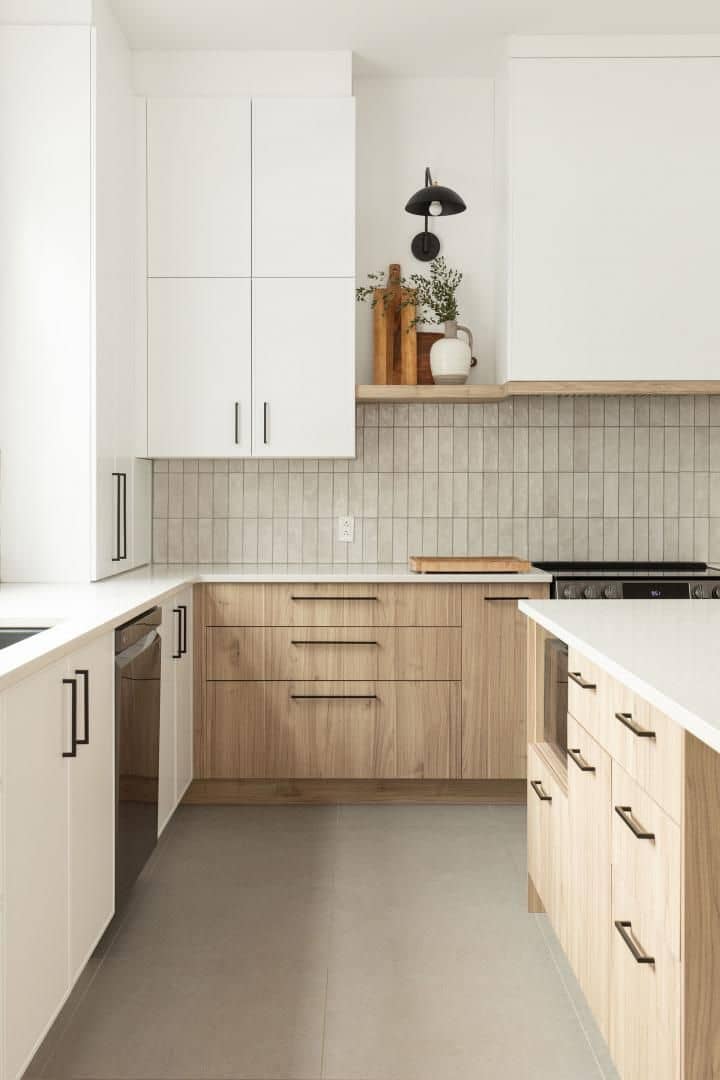
- Bathroom
Modern Bathroom Design In 2025: The Ultimate Guide
- By matin@quayconstruction.ca
Table of Contents
Walking into a beautifully designed modern bathroom feels like stepping into your own private spa retreat—a sanctuary where functionality meets sophisticated aesthetics. Modern bathroom design has revolutionized how we think about these essential spaces, turning what was once purely utilitarian into the centerpiece of contemporary home design. Whether you’re planning a complete renovation or looking to refresh your existing bathroom, understanding the principles of modern bathroom design will help you create a space that balances beauty, innovation, and practicality.
The Evolution of Modern Bathroom Design
The concept of the bathroom has undergone a remarkable transformation over the past century. What began as a basic functional space has evolved into an area where homeowners express their personal style while embracing cutting-edge technology and sustainable practices. Modern bathroom design breaks away from traditional constraints, introducing open concepts, minimalist aesthetics, and smart features that enhance both form and function.
Today’s modern bathroom designs emphasize:
- Clean lines and uncluttered spaces
- Natural materials with technological innovations
- Sustainable fixtures and energy-efficient solutions
- Personalized experiences through smart technology
- Wellness-focused elements that promote relaxation and self-care
According to recent industry surveys, over 78% of homeowners now consider the bathroom one of the most important spaces when evaluating a property’s value and appeal. If you’re considering upgrading your space, you might be surprised to learn that a bathroom renovation can be completed in as little as 10 days with proper planning and professional execution.
Key Elements of Modern Bathroom Design
Minimalist Layouts
The foundation of modern bathroom design rests on creating spaces that feel open, airy, and uncluttered. This approach typically involves:
- Wall-mounted vanities and toilets that create the illusion of more floor space
- Hidden storage solutions that maintain clean sightlines
- Floating shelves instead of bulky cabinets
- Frameless glass shower enclosures that visually expand the space
“The minimalist approach isn’t about having less—it’s about making room for what matters,” explains renowned interior designer Emma Chen. “In modern bathroom design, this translates to intentional choices that remove visual noise and highlight quality materials and thoughtful details.”
Innovative Materials and Textures
Modern bathroom design embraces a diverse palette of materials that blend durability with visual interest:
| Material | Characteristics | Best Applications |
|---|---|---|
| Large-format porcelain | Low maintenance, versatile, water-resistant | Flooring, shower walls, feature walls |
| Terrazzo | Durable, unique patterns, eco-friendly options | Countertops, flooring, accent pieces |
| Matte black fixtures | Fingerprint-resistant, dramatic contrast | Faucets, shower heads, cabinet hardware |
| Engineered quartz | Non-porous, consistent appearance, durable | Vanity tops, shower niches, window sills |
| Sustainable woods | Warmth, natural element, humidity-resistant varieties | Vanities, accent walls, shelving |
The interplay of textures has become a hallmark of modern bathroom design. Designers frequently pair smooth, glossy surfaces with organic, textured elements to create visual and tactile contrast that adds depth to minimalist spaces.
Statement Fixtures and Features
In modern bathroom design, fixtures transcend their functional roles to become artistic focal points:
Freestanding Bathtubs
No longer relegated to the corner, today’s sculptural tubs often take center stage in modern bathrooms. Materials range from traditional porcelain to contemporary concrete, natural stone, and even wood.
Architectural Shower Spaces
The modern shower has evolved from a practical necessity to an immersive experience. Features include:
- Curbless, open designs
- Multiple showerheads and body sprays
- Integrated seating and niches
- Dramatic lighting effects
Bold Sinks and Basins
Vessel sinks, trough-style basins, and integrated countertop designs offer opportunities to introduce distinctive shapes and materials.
Color Trends in Modern Bathroom Design
While the white bathroom remains a timeless choice, contemporary palettes have expanded to include:
Moody Monochromes
Deep blues, forest greens, and charcoal grays create sophisticated, cocoon-like environments. These darker hues are particularly effective when paired with strategic lighting that highlights architectural features and creates a sense of depth.
Earth-Inspired Neutrals
Warm beiges, soft taupes, and gentle greige tones offer a more organic alternative to stark whites. These colors work beautifully with natural materials like wood and stone, creating calming environments that connect to nature.
Strategic Color Accents
Modern bathroom design often employs the 80/20 rule—using neutral tones for 80% of the space while introducing bolder colors through easily changeable elements like towels, accessories, or a feature wall.
Technology Integration in Modern Bathroom Design
Smart technology has transformed modern bathroom design, introducing conveniences that were unimaginable just decades ago:
- Digital shower systems with programmable temperature and flow settings
- Mirror TVs and integrated sound systems
- Intelligent toilets with heated seats, bidet functions, and automatic lids
- Motion-activated faucets and lighting
- Heated flooring with smart controls
- Voice-activated features for hands-free operation
Sustainable Approaches to Modern Bathroom Design
Environmental consciousness has become non-negotiable in contemporary design. Modern bathroom design addresses sustainability through:
Water Conservation
- Low-flow toilets that use less than 1.28 gallons per flush
- Water-saving faucets and showerheads with aerators
- Greywater recycling systems that reuse sink and shower water for toilet flushing
Energy Efficiency
- LED lighting that reduces electricity consumption
- Tankless water heaters that heat water on demand
- Skylights and strategically placed windows that maximize natural light
Sustainable Materials
- Recycled glass countertops and tile
- Rapidly renewable materials like bamboo and cork
- Zero-VOC paints and finishes that improve indoor air quality
Accessibility in Modern Bathroom Design
Today’s forward-thinking designs incorporate universal design principles that accommodate users of all ages and abilities:
- Zero-threshold showers with built-in seating
- Comfort-height toilets
- Lever-style faucet handles
- Strategically placed grab bars that double as towel racks
- Motion-sensor lighting
- Non-slip flooring materials
These features aren’t just practical—they’re integrated seamlessly into the design to create bathrooms that are both beautiful and functional for everyone.
Space Optimization in Modern Bathroom Design
Not every modern bathroom enjoys abundant square footage. Designers have developed numerous strategies to maximize functionality in compact spaces:
Visual Expansion Techniques
- Continuous flooring from the main space into the shower
- Mirrors strategically placed to reflect light and create the illusion of depth
- Wall-mounted fixtures that free up floor space
- Glass partitions instead of solid walls
Multifunctional Elements
- Shower niches that eliminate the need for caddies
- Vanities with integrated laundry hampers
- Medicine cabinets recessed into wall cavities
- Towel warmers that also provide ambient heating
Lighting Strategies in Modern Bathroom Design
Thoughtful lighting transforms the bathroom experience and is a cornerstone of modern bathroom design. A comprehensive approach typically includes:
- Ambient lighting: Provides general illumination through ceiling fixtures, recessed lights, or cove lighting
- Task lighting: Focused illumination for specific activities like grooming or applying makeup
- Accent lighting: Highlights architectural features, artwork, or special materials
- Natural lighting: Maximized through windows, skylights, or light tubes
Many contemporary bathrooms feature programmable lighting scenes that adjust brightness and color temperature based on time of day or activity.
Planning Your Modern Bathroom Renovation
Before embarking on your modern bathroom transformation, it’s essential to understand what you’re getting into. A well-planned renovation starts with:
- Budget planning: Understanding how much a bathroom renovation costs will help you make informed decisions about where to splurge and where to save.
- Comprehensive planning: Following a complete bathroom renovation guide can help ensure you don’t overlook important aspects of the project.
- Start with a clear vision: Collect inspiration images and identify elements that consistently appeal to you.
- Prioritize your needs: Focus on features that align with your daily routine and lifestyle.
- Consider the long view: Choose timeless elements for permanent fixtures and express trends through easily replaceable items.
- Don’t compromise on quality: Invest in high-quality materials and craftsmanship for elements that experience daily use.
- Maintain proportion: Ensure fixtures and features are appropriately scaled to your space.
For additional inspiration, check out the most popular bathroom designs that showcase how these principles come together in real-world applications.
Conclusion: The Future of Modern Bathroom Design
The evolution of modern bathroom design continues to accelerate, with emerging trends pointing toward even more personalized, wellness-focused spaces. From chromotherapy shower systems to circadian lighting that supports natural sleep cycles, tomorrow’s bathrooms will increasingly function as in-home health centers.
What remains constant is the desire to create spaces that serve as daily sanctuaries—environments that not only meet our practical needs but elevate our everyday routines into moments of comfort and luxury. Modern bathroom design, at its core, recognizes that these spaces are no longer afterthoughts but essential components of a well-designed home that supports physical and emotional wellbeing.
Whether you embrace cutting-edge technology or prefer a more organic approach, the principles of modern bathroom design provide a versatile framework for creating spaces that feel both contemporary and timeless. By focusing on quality materials, thoughtful layouts, and personalized details, you can transform your bathroom into a space that truly reflects modern living at its best.
Related Posts

Kitchen Remodel vs Renovation: Which Is Right For You (DUPLICATE)





